Figure 1.
Proposed future research on age, environment and lifestyle and ART-associated sperm epigenetic changes in humans and mice over their life span. The use of prospective design for human studies and animal models for investigation of age, epigenetic changes and consequent events in offspring among the next generation(s) looks promising and is recommended to be implemented. (A) Although longitudinal human studies over life span stages (childhood, puberty, young adulthood, adulthood, APA, elderly age) are time intensive, expensive and difficult to do, they are more conclusive and, therefore, this needs to be proposed. Animal models have an invaluable advantage of removing the environmental and lifestyle factors from the design and they can be conducted much faster. (B) Involvement of healthy population including twins (human), prospective follow up, controls and use of environmental and lifestyle factors, fertility status and method of fertilization in designs are recommended to distinguish (1) age-associated changes; (2) environment and lifestyle changes; (3) fertility-associated changes; and (4) ART-induced changes of the sperm epigenome. *Equivalency of mouse reproductive ages to these of humans was determined based on previously published data (Flurkey et al., 2007; Brust et al., 2015; Bell, 2018) as well as information from Charles River Laboratories that male mice breeders are usually retired by 9 months of age (270 days) due to the decline of their reproductive efficiency. ART, assisted reproductive technologies.

